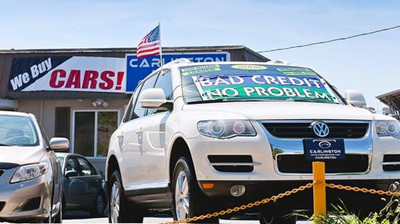美國汽車貸款
Bad carma
因果循環
Borrowers, not lenders, have more to fear from the latest subprime lending boom
貸款人,而不是出借人,更加懼怕最近次級貸款的繁榮
For whom?
為了誰
WHAT would you rather lose: your house or your car? In America, where a car is usually essential to get to work, many borrowers would sooner lose their house, which explains why in the years after the crisis, mortgages were more likely to go bad than car loans. It also explains why auto loans, unlike mortgages, are booming. New loans reached 371 billion in the year to June, up 7.4% from the previous year and 64% since 2009. Subprime auto loans, made to the riskiest borrowers, have grown even faster, by 93% since 2009.
房子或者是汽車,你舍得哪一樣?在美國,汽車對于上班族來說常常是必不可少的,許多貸款人可能很快失去他們的房子,這解釋了為什么在危機之后的幾年,住房抵押貸款比汽車貸款更加容易惡化。這也說明了為什么汽車貸款不像住房抵押一樣正經歷著一場繁榮。到今年六月份,新的貸款量已經達到了3710億美元,比去年上升了7.4%,自2009年來提升了64%。給予高風險的貸款人的刺激汽車貸款增長得更快,自2009年以來上升了93%。

This growth is due to rising car sales and ample credit as banks, finance companies and carmakers' financing arms compete to lend to consumers, either directly or via car dealers. Those loans are then packaged into securities for yield-hungry investors. Experian, a credit-scoring agency, reckons 85% of new and 54% of used cars are now bought with loans, compared to 79% and 52% in 2007.
這樣的增長是由不斷增加的汽車銷量以及銀行、金融公司和汽車制造商財務分支競相直接或通過分銷商借款給消費者的豐富貸款造成的。這些貸款最后被包裝成證券交給渴求利潤的投資者。信用評級公司益佰利評估:85%的新車和54%的舊車是用貸款買的,相比之下,2007年兩者數據分別為79%和52%。
As volumes have soared, underwriting standards have slipped, with the average subprime loan rising to 115% of the car's value this year from 112% in 2011, according to Standard & Poor's, a ratings agency. The average life of a loan has grown too, to more than five years. Delinquencies, naturally, are rising: more than 3% of loans are at least 60 days in arrears, up from 2% in 2011.
隨著總量的激增,證券包銷標準也下降了,根據評分機構標準普爾公司的數據,平均次級貸款從2011年占汽車價值的112%上升到了今年的115%。平均借貸周期也延長到超過五年。違約行為自然地多了:超過3%的貸款至少有60天的逾期,而2011年是2%。
There is much talk of a new subprime bubble, akin to the cavalier mortgage lending that helped spark the financial crisis. The Department of Justice has asked two big car-loan companies, GM Financial, a unit of General Motors, and Santander Consumer, controlled by Spain's Santander Group, for details about their subprime underwriting and securitisation.
有關新的次貸泡沫有許多討論,就好像目空一切的房屋抵押貸款引發了金融危機那樣。司法部要求兩大汽車借貸公司—通用旗下的通用金融和西班牙桑坦德集團控制下的桑坦德消費銀行—提供其次級證券包銷標準以及證券化的細節。
Yet the two markets are fundamentally different. Start with size. At 905 billion, total auto loans are barely a tenth of total mortgage debt. Subprime is also more established in auto lending, accounting for 20% to 30% of total loans since 2000.
但是這兩個市場是明顯不一樣的。就規模來說,9050億美元的汽車貸款僅僅是房貸總額的十分之一。次級貸款占了汽車貸款的很大比重,從2000年來占據了貸款總量的20%到30%。
The mortgage bubble fed on the delusion of both borrowers and lenders that house prices could only rise and thus a loan could always be repaid. In contrast, lenders assume cars only depreciate, and charge accordingly: annual subprime interest rates average 14%, and 25% is not uncommon. Cars are also easier to repossess and resell.
房產泡沫基于出借人和貸款人的幻想——房價只能漲,這樣貸款才能一直被支付。相反,出借人只期望汽車貶值,并且相應地進行收費:年均次級貸款利率為14%,甚至25%也不是鮮見。汽車也更加容易再次買賣。
So while losses are likely to mount, lenders do not face a mortal threat. It is borrowers who have more reason to worry. A car loan is a complex transaction that hinges not just on the price of a car, but also on its trade-in value, extras such an extended guarantee or rust proofing, and most important, the interest rate. A dealer typically selects a quote from a bank or finance company via his computer and marks it up. The higher the markup, the greater the payment he receives from the lender.
所以盡管有可能增加損失,出借方并未面臨致命的威脅。貸款人才更加應該多操心。汽車貸款是個以復雜的交易,它不僅和汽車價格掛鉤,也和其抵價值,額外的費用如延長保修時間或者防銹處理以及最重要的利率有關。交易員一般通過電腦引用銀行或者金融公司的報價再加上一定價。價加得越高,他從出借方得到的報酬也就越高。
Consumer advocates fret that this process leaves the unsophisticated—as subprime customers tend to be—at the mercy of unscrupulous dealers. They may be charged a higher rate despite qualifying for a lower one, sold unneeded or overpriced extras, or even told, a few days after they drive off with the car, that their loan was turned down and they must pay a higher rate. “None of the prices are fixed, and each unfixed price is a potentially abusive negotiating point,” says Tom Domonoske, a lawyer who represents aggrieved buyers. Consumer advocates would like markups replaced with a flat fee.
消費者保護機構擔心這個過程會讓那些沒有經驗的消費者—次級貸款顧客往往是這樣—受不良交易員的支配。他們可能被收一個更高的利率,盡管他們有資格獲得更低的利率,并且“被消費”不必要的或者過高價格的附加項,甚至在他們開了幾天車之后被告知他們的貸款唄取消了并且他們必須支付一個更高的利率。受害消費者的代表律師Tom Domonoske說:“這些價格沒有一個是固定的,并且每一個不固定的價格都是一個潛在的被濫用的談判砝碼。”消費者權益維護者期望用穩定的費用取代加價。
The Consumer Financial Protection Bureau (CFPB), a new watchdog agency set up after the financial crisis, is also worried that lots of borrowers get a raw deal. It has told banks and finance companies that it holds them responsible for the behaviour of the dealers they work with, and that it considers dealers' discretion over markups an invitation to discrimination. It has already got one big finance firm to pay 98m to settle a claim that it was charging minority borrowers higher interest rates and is investigating others.
金融危機后設立的監管代理—消費者金融保護局也擔心許多貸款人被不公平對待。它已經告知銀行和金融公司,要求他們對合作的交易員的行為負責,并且它認為交易員就加價的任意決定權是一種歧視。它已經讓一個大的金融集團支付9800萬美元,因為該集團向少數貸款人收取高額的利率,另外保護局還在調查其他公司。
Dealers are fuming at the CFPB's muscle-flexing. Competition, they say, ensures that customers get the best rate; dealers need discretion to compete. By raising costs, stricter regulation may actually reduce the amount of credit available.
交易員對于保護局的武力示威憤憤不平。他們說,競爭保證了消費者獲得最好的利率:交易員需要自由決斷權來應對競爭。通過提高成本,更嚴格的規章可能實際上減少信貸的提供量。












